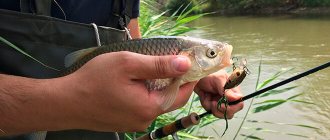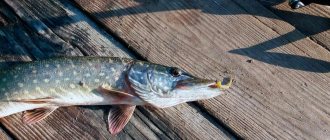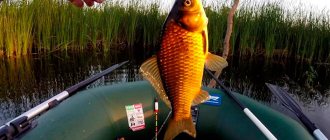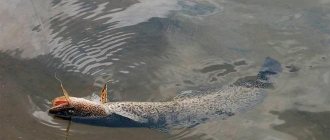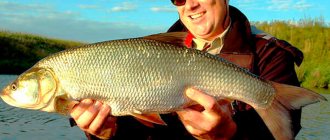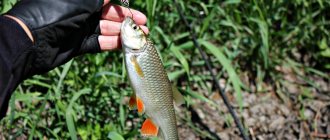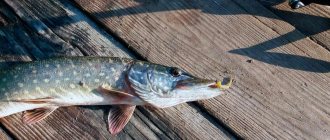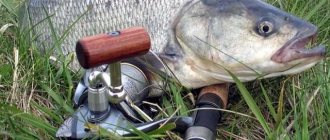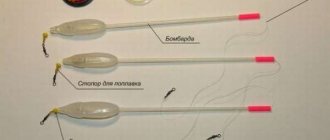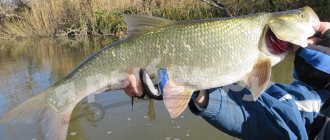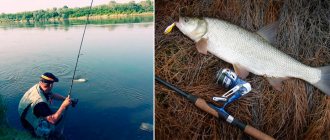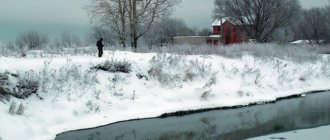Catching asp with a spinning rod is, without exaggeration, a most exciting activity. You can even safely call it a hunt, because tracking down, outwitting and ultimately spotting a fast-moving opponent is not an easy task.
During the period of spawning bans on fishing, you can have a good rest and go fishing outside the Russian Federation, for example in the neighboring country of Kazakhstan at recreation centers on the picturesque Lake Balkhash. You can also go to orders for fishing tours and entertainment at the Zavidovo base online to improve your understanding of the area.
Let's figure it out together:
- where to look;
- what and how to fish;
- what are the preferences and habits of the sheresper;
- behavioral patterns at different times of the year;
- what gear and bait to prepare and much more.
Meet the river horse, aka asp, aka sheresper
The habitat of the Red Book predator-asp is quite wide. It can be found in the river waters of central (European) Russia, Western Europe, along the entire length of the Urals (Eika), Rhine, Svir.
In the tributaries and coastal zones of the Aral Sea and the Caspian Sea, special subspecies live - the Aral and red-lipped asp. On the territory of Kazakhstan, it was artificially introduced into Lake Balkhash, took root there and successfully establishes spawning grounds.
Prefers water that is well enriched with oxygen, clean, with a current (usually deep water, medium intensity or rapid current, turbulence). Avoids silty places and standing dirty water.
Depending on its habitat, the sheresper has certain behavioral characteristics. In conditions of large rivers, seas, large lakes, it chooses deep water with a current (on lakes, such a current is formed near the mouth of rivers), places between river mouths, with their characteristic turbulence.
According to encyclopedic data, sheresper cannot be caught in Siberia, the North Caucasus and Far Eastern reservoirs. But in the foothill sections of rivers such as Pshish, Kurdzhips, Psekups and other mountain reservoirs of the Caucasian foothills, medium-sized specimens are often found, and also the Amur asp (rudd), which can become a trophy on a Far Eastern river.
Where to look for asp on small and large rivers
Sheresper belongs to the carp family and is one of the few predators within this family. Sits on a donk, float tackle, but still, the classic for asp fishing is a spinning rod.
Since we are talking about a predator, it follows that he eats where there is something to eat. Such places include coastal areas with willow thickets, estuaries, snags, sand spits, whirlpools and other places where you can hide in ambush and track down schools of small fish. Asp indicates its presence mainly by cruising a dark shadow near the surface and periodically animated splashes of water.
The sheresper is a good tactician; he does not chase every fish that swims past, but waits for the fry to gather in one dense school. The predator attacks in the middle and hits with its tail, stunning the fish. Disoriented fry become easy prey. When collecting small fish, there is a chance that the angler's bait will also be caught. But the cast must be accurate, if possible to the center of the flock.
Despite the fact that most manuals say that the asp lives exclusively in rivers and does not like standing water, if the lake is fed by a river, then the asp may well choose several parking areas and hunting grounds.
Lake asp are caught using bait that closely matches the food supply in the natural environment. It is worth emphasizing that, after all, this fish is a river fish and entering floodplain lakes and similar standing waters is more likely a frequent accident than a regular pattern.
Fact, asp can adapt to brackish water. For example, interesting fishing for the “river horse” is celebrated by fishermen on Lake Balkhash. There the predator feeds on roach, the young of which stay in the coastal zone, where the water is warmed by the sun.
There is no need to track the Balkhash asp for a long time. You can also compete in an intellectual sporting duel with an ichthyophage of aquatic fauna in the Gulf of Finland, where the salt content is 9.2%.
In early spring, on small rivers the predator sticks to the bottom. This feature should be taken into account when searching for prey. The baits used are various, both jig heads and spinners - spinners, spoons.
This season, the most effective fishing will be slow, in which the bait does not rise, but plays in the lower layers of the water. In summer, the wiring changes to more intense, this corresponds to changes in the seasonal habits of the predator.
Fishermen share their experience and claim that a trophy specimen in the spring is more accessible in cold weather when it snows and rains.
On large rivers the current is weaker, and given the asp’s commitment to water well enriched with oxygen, it is worth focusing on the fairway area, bridge supports, fast shallow channels, any obstacles that create an obstacle to the flow, due to which turbulence occurs.
It is in such areas that the water contains the most O2. In general, any areas that can serve as good shelter, with high water quality, and small things that attract flocks are also interesting to the asp.
If the sheresper does not form a cauldron, then such a place can be identified by the presence of seagulls. Where feathered fishermen gather for a feast, there is every chance of catching an asp.
Boats must approach such places with extreme caution. At least 200 meters away, you should turn off the engine and approach with oars. You should not come closer than 70-80 meters to the battle site. This is a sufficient distance to see the activity of a predator and accurately cast.
The asp goes hunting on the riffles mainly at dusk, when the sun has just appeared above the horizon or is already going beyond it. During the daytime, it prefers steep, willow-covered banks with reverse currents.
Especially large individuals hunt on the rifts, but they are also more cautious, so it is necessary to choose the appropriate equipment.
The braid can be replaced with transparent monofilament; in extreme cases, its color should be dim. But returning to the advice of experienced people, it is the cord that makes it possible to cast over a long distance, and at the same time, reliability and confidence that the rapid attack and resistance of the predator will not contribute to the breakage of the tackle.
Tactics and fishing techniques
Depending on the time of year, the specific fishing location and fishing habits, you can choose one of several tackles - fly fishing, spinning rod, float rod. Regardless of which gear you prefer, you need to know the subtleties to increase the likelihood of successful fishing.
Fly fishing
This option is justified at the beginning of summer, when the asp gathers in flocks and kills the fry. At this time, he does not disdain tasty insects. When choosing a suitable reel, give preference to lightweight models that can hold a lot of fishing line. There must be a reliable and comfortable brake - a second delay can cost a trophy. It is not necessary to take a long rod; even when fishing from the shore, 3-3.5 meters is enough. But it must be durable - if you are going to fish for such a strong fish as asp, you should not buy cheap Chinese crafts, the quality of which is questionable. It is important to choose the right fly - the color and shape correspond to the insects that are common near the reservoir. An unfamiliar bait will certainly scare away the asp.
To learn more:
Bite alarm with pager
Having arrived on shore, you need to develop a suitable plan of action. At the beginning of summer, the predator gathers in schools, driving the fry, and collective hunting is used, which shows the high level of intelligence of the fish. By finding a cauldron (a place where a school of asp drives the fry) and throwing gear there, you can count on a good catch. In such cases the bite follows immediately. If you can’t find the boiler, you need to cast the fly onto the rapids, and not into the active stream of the current, but to the border where the flow is not so rapid.
Many fishermen disagree on whether the asp takes the fly right away or waits until the current brings it under his nose. Try both options - let the bait move with the flow of water, without relaxing for a second - be prepared for a sharp hook.
Spinning
This gear is great for fishing in the warmer months and should be chosen seriously. Spinning for catching asp from a boat, boat and from the shore will be a good solution, and even the equipment will not be too different. The rod itself must be long - at least three meters, because you will have to cast the bait far. The optimal test is 50-70 g. It is better to take a spinning reel, although a multiplier one is also suitable if you have to fish from the shore or from a boat at the end of summer, when the asp becomes cautious.
There are no preferences in choosing fishing line. Monofilament, braided - depends on habits. The optimal diameter is 0.2-0.3 mm. This fish does not have sharp teeth like pike perch or pike, and a metal leash is not needed. As bait for catching asp, it is advisable to have several baits on hand - the preferences of the predator change sharply and unexpectedly. A spoon that caught a great bite a week ago may turn out to be useless today.
The castmaster for asp is popular - due to its large weight, it can be thrown over a considerable distance. Bombarda, known as sbirulino, performed well. A large float pulls the bait, which in strong currents and shallow depths jumps over the rocks, like a fish looking for edible insects. The asp probably won't resist. Vladimir Struev talks interestingly about this bait in the video below.
Experienced fishermen do not forget proven spoons. A spoon weighing 30-45 g helps out in cases where other baits are useless. A small wolfer can also be a good choice.
To learn more:
How to make a girder for pike
You should approach fishing carefully. For example, when hunting for pike, fans of spinning rods try fishing through different layers of water. If the target is an asp, it makes sense to give preference to the upper and middle wires - he rarely hunts below. Therefore, after casting the bait, either start retrieving it immediately or after a second so that the spoon or castmaster does not have time to lie on the bottom.
Asp is an extremely smart and cautious fish, which is noticeable when catching large, trophy and therefore desirable specimens. When fishing from a boat, try not to swim closer than 60-80 meters to the casting point. The slightest noise or unfamiliar silhouette will scare the asp, and then fishing will not be as successful as we would like. That’s why catching asp with castmaster and heavy spoons is so popular among masters – they are cast over a long distance. Of course, in such cases it makes sense to choose braided fishing line. It is lightweight and allows you to make long casts.
Float rod
Asps are caught relatively rarely with this tackle, although there are such masters. They can be understood - cautious fish rarely bite the bait, but the process of catching even a kilogram specimen will bring a whole range of feelings. It is not advisable to use a fishing line thicker than 0.3 mm - this will scare away wary fish. But if a specimen weighing 5-7 kilograms is tempted by the bait, it will not be easy to pull it out.
The fishing rod should be long - at least 3.5 meters, and preferably more. There are no special requirements for it; it is better to take the most convenient one. Inertia-free will allow you to make long casts and eliminate the possibility of the line getting tangled. Finally, the float. It’s better to take a transparent one - it’s almost invisible, which means it won’t attract unnecessary attention. True, these are not always available for sale, so some craftsmen use homemade floats.
When casting, try not to get too close to the water; stay against the backdrop of bushes and not in open areas. A strong, brave, but cautious asp, having noticed the shadow or silhouette of a fisherman, may well go to another place. That is why it is better to choose a long fishing rod - you can cast bait without coming close to the coastline.
Tackle for catching asp using spinning rod
Tackle and equipment are selected in accordance with the conditions of the reservoir, weather, type and style, as well as the intended trophy.
Spinning rod for catching asp from the shore
For asp hunting from the shore, sticks in the range of 2.4 to 3.0 meters are convenient (if we are talking about a wide body of water and there is a need for long casting). In this case, the rod’s structure and test must withstand the weight of the bait 35 grams. and it’s easy to send it over long distances.
The priority is gear with a medium action. Many spinners note that parabolic poles are the best option. Thanks to its characteristics, this spin allows you to make long casts with different weights of bait.
There is a drawback, which is the hooking. The high elasticity of the rod does not allow sudden jerks when the bait is cast over a long distance. The maximum efficiency of this type of system is achieved in combination with braided wire.
Rods for fishing from the shore. TOP 5 (from budget to more expensive):
- AIKO Espada ESP240ML , a convenient plug-in composite pole for spinning from the shore and from the boat. Medium sensitivity. Spin is used, in particular, when fishing with jigs. Designed for testing bait from 5 to 25 g.
- Salmo Aggressor Spin 25 270 . Designed for bait up to 25 gr. The speed is stated to be fast, but according to reviews it is closer to medium-fast. A democratic option, at the same time, in appearance and efficiency it is not inferior to analogues from a more expensive segment. Equipped with budget fittings and inexpensive decorative elements.
- Yoshi Onyx Casta 902MH . Build fast, test 8-35 gr. Copes well with heavy baits for long casts. Belongs to the premium class, this is one of the best budget spinning rods. Stick length 270cm.
- Silver Stream Taifun N TN802 . A short and light stick, very convenient when casting in conditions of rough vegetation (thickets of reeds, willows, other bushes and trees, etc.), where there is a high probability of encountering an obstacle even at the casting stage. Its length is 240cm, weight 120g. Test from 4 to 14g. Medium - fast action, high elasticity in operation, good characteristics for accurate casting.
- Legend Elite LES96MHF2 from St.Croix . The length of the rod is 293 cm with a weight of 164 g, the action is fast, the maximum test is 28 g, the minimum is 10.5 g. It is noted by users as a particularly accurate casting tool, comfortable for the hand, with a high “feel”. The blank is made of high-modulus graphite with ultra-light properties, especially for powerful fishing rods. Positioned as a salmon spin, but perfectly suits the asp hunting technique.
For long, medium-budget poles, you can pay attention to the Shimano Catana BX Spinning 300 MH.
Reel for long casting with 3000-4000 spool. For good tackle, it is better to choose a high-speed reel with increased durability.
Ideally, a spinning rod should have the ability to cast long distances, for guiding in the upper layers of water and withstand significant jerks of trophy specimens (10-12 kg, because every fisherman goes for just such a spinner). Although the average weight of the predator that is most often caught is in the range of 1-5 kg.
Multiplier reels are convenient for trolling, but in asp hunting this is not a very convenient option. It is better to equip the rod with an inertia-free high-speed reel, with a speed of 6.2-7.2.
The best spinning rods for asp from a boat
One of the non-budget options noted by anglers is the Legend Elite LES86. This stick has a high level of transmission of actions on the other side of the fishing line, that is, high sensitivity. Although this indicator is not particularly important for asp fishing.
The optimal action and cork handle allow you to hunt comfortably in difficult and tight conditions, accurately cast the bait and fish out resisting prey in conditions of current and other obstacles. The length of the rod is convenient for fishing for asp from a boat, about 2.6 m. The weight of lures for Legend Elite LES86 is from 7 to 56 g.
This is not the only option; there are also cheaper spinning rods, for example, Aiko Lanzar II LAN270MH. Large spread of dough over the bait, from 8 to 42g.
The manufacturer claims that this is a universal rod for the main types of predator (perch, pike, asp, pike perch). Length 2.7 meters, action medium-fast. For your information, this rod is quite suitable for fishing from the shore.
The spool of a spinning reel from a boat should be of medium volume, from 2000 to 2500. Important - when winding the cord/line, the reel should be filled to the brim.
Is there a universal spinning rod?
What if you need a universal spinning rod of medium power
(5-25g.), for example, for fishing with popular techniques: jig and twitching.
Is it possible to choose a universal option here? In this case, spinning can be called universal only under certain conditions
:
Condition 1.
If baits of approximately the same weight (10-18g) are used.
Condition 2.
If the universal rod length is used, which is about 7.6 feet or 2.29 meters.
Condition 3.
The spinning rod must be of high quality. Made from high modulus carbon fiber and assembled in Japan. Such spinning rods have a complex structure that can suit different conditions. The spinning material will provide a high level of sensitivity and control over the bait (in jigging and twitching).
Only under specific conditions:
Short twitching spinning rods (up to 2.1 m) or long jigging rods (2.7-3 m) will work perfectly only for the purposes for which it is made. They will be less suitable for some other tasks, and not suitable for others at all. They cannot be called universal in any way.
We've sorted out the nuances of versatility. Now let's talk about choosing a spinning rod.
These characteristics almost completely describe the fishing rod for a particular body of water. So, the length allows you to determine the casting distance, having a direct relationship - the longer, the further. The test, in turn, shows how heavy the bait can be delivered to the desired area of the reservoir and partially determines what weight of fish is expected to be caught.
As mentioned above, spinning is a universal tackle. However, if when fishing from a boat the set of criteria is very limited, since fishing is actually carried out in open space, then when casting from the shore, all possible influencing factors must be taken into account. It is necessary to pay attention first of all to the following characteristics:
Neglecting at least one of these factors can lead to complete discomfort during fishing and its accompaniment by constant snagging on coastal vegetation, tangling of the fishing line and, as a result, the end of fishing. In order to wisely choose a spinning rod for fishing from the shore, you need to understand the parameters described below.
Price and type of rod
Before buying a spinning blank, you need to carefully study the market, since there are a huge number of offers there. And very often you can find a budget rod within 3,000 rubles, which in its characteristics will be similar to a product produced by a famous brand and having a retail price of 30,000 rubles and above.
And yet, despite the fact that the brand is a significant, but not fundamental, circumstance, it should be noted that among both beginners and experienced fishermen, rods from Daiwa and Shimano have a good reputation; manufacturers Banax, Nissin, Tenryu are a little less known. The range of these companies is very large and allows you to choose a set of rods for the required type of fishing.
Tips for fisherman: Asp balyk at home recipe - How to best use
Based on their technical design, forms are divided into plug-in and telescopic. The first ones consist mainly of two parts and are connected end-to-end using a plug connection. This guarantees them high strength, uniform load distribution and, accordingly, excellent balance.
Rods of the second type are very outdated; their only advantage is their compactness during transportation, which made them popular mainly among lovers of float and bottom tackle. Accordingly, when fishing with spinning tackle from the shore, it is better to give preference to a plug form.
Primary parameters for choosing a fishing rod: test and length
These characteristics almost completely describe the fishing rod for a particular body of water. So, the length allows you to determine the casting distance, having a direct relationship - the longer, the further. The test, in turn, shows how heavy the bait can be delivered to the desired area of the reservoir and partially determines what weight of fish is expected to be caught.
Rods have a very different test, and extreme values can be from tenths to a unit of grams when fishing with ultra-light baits, and from tens to hundreds of grams when hunting fish such as taimen, salmon, catfish or very large pike using special oscillating spinners. Universal values for most reservoirs when fishing from the shore will be 7-30 grams, 5-15 grams, 5-25 grams or close to them, i.e., no more than 30 grams and lying in a wide range.
It should be remembered that it is better to choose a test with a small margin, ideally so that the mass of the bait is its average value. As an example, if you plan to cast a spinner weighing from 7 to 15 grams, then a rod test of 5-25 grams would be ideal.
Rod build
This parameter should be displayed in a separate column, since it ultimately characterizes the form of the rod and determines what baits will be used for fishing. In fact, it indicates the information content of the tackle when casting, retrieving and retrieving, depending on the type of equipment. Despite the fact that this is a separate and very large topic, you should at least superficially study this parameter in order to correctly select a spinning rod for fishing from the shore.
The action is indicated on the form of the rod; it is convenient to divide it into three types:
So, as can be seen from the description, for beginners or anglers who do not have sufficient information about the reservoir, it is recommended to use a medium or, as it is called, semi-parabolic system. This rod will allow you to use a wide range of baits, provide optimal casting and comfortable fishing.
The quality of the rod blank
Guide rings on the rod blank are also made of different materials, but all-metal ones are increasingly leaving their positions, and their place is being taken by designs with various spacers made of ceramics, Teflon, etc. This innovation eliminates the unpleasant phenomenon of the fishing line rubbing against the ring material, followed by breakage and loss of valuable bait.
Zerger , I assume that you put spinning rods to the vote that can be used specifically for asp fishing? Do I understand correctly that I can use the search, read reviews and make decisions for myself on any stick from the list?
Of the sticks, the ones that I personally caught were: 1 - Lamiglas Certified Pro LLS , 2.92 m, with a test of 3.0-10.0 g - the stick is not bad, but it did not become the basis, since it was supplanted by the main one at that time.
3- ST.Croix LES 86MF2 , up to 21 g. Excellent long-range shooter from the salmon series, replaced my old Calqueta in 2010 to this day. There are no complaints, all the excellent advantages of pure asp (range, accuracy and jerk control), allows It’s still decent to jig from the shore. One of the best all-rounders for shore guards.
Now there will be a lot of letters, if you are too lazy to read, then you can go below - straight to the list of fishing rods.
A certain paradox emerges - flexible and flexible rods for thin lines with decent rigidity and minimal residual vibrations for jerking animation
Now you can decide on the models: 1. Silver Stream Taifun N TN802 UL (from the new series, on the old ones the rings are too heavy and overload the tip for animation of walkers, casting with one hand is inconvenient) 2. Yamaga Blanks Battle Whip BW-82MLX (the best from the list for work with walkers) 3. Tict B4 Befo bFO-80T (the rings on the tip are not the best and there may be problems with walkers) 4. Norstream Stage SG-86L or SG-86ML 5. Graphiteleader Rivolta GRIS 772L (the shortest on the list, but longer than Tira)
If someone adds to my short list, I will be only glad.
I tried to put all the rods mentioned in this topic into a poll at the top of the topic, I hope my colleagues will help you decide. Good luck with your choice!
Zerger , I assume that you put spinning rods to the vote that can be used specifically for asp fishing? Do I understand correctly that I can use the search, read reviews and make decisions for myself on any stick from the list?
And now why I started asking questions in the graphite leader thread. In my city, where fishing rods are problematic in general, a certain number of them were brought, and so I wondered, could this be suitable for catching asp? But, as far as I remember, the Rivolta you cited is not available in the store, but the Tiro 762L is available. I asked a question about Tiro, but didn’t get much information. Something like that.
Tips for fisherman: Which spinning rod to choose for trout fishing - Answers for beginners
I am sure that it will not be suitable for the tasks of catching asp, as a long-range one. Since I caught with this Zed smaller up to 10g (Zedd 76L), at a height of 2.29 m. My partner has such a spinning rod, so when fishing with the same weights, and this is Light , then we used weights of 6-8-10-12 g, so my Arion 76 also weighed up to 12 g, it moved it quite easily.
Time zone: UTC + 2 hours
Who's at the conference now?
This forum is currently viewed by: “ALEX”, alex_y, Anton, Bing [Bot], Sanchoo, shewa, VladFOX and guests: 9
You can use monofilament and braided cord when rigging a spinning tackle for asp. The first, given the aggressiveness of the predator, has some advantage. Both fishing line and cord must have a breaking force of at least 5 kg.
Line or cord
It is difficult to answer this question unequivocally. The temperament of the asp leaves no doubt, and braided fish is definitely better for landing such fish. But given the caution of the fish, it is better to use a transparent thread. Both the opinions of fishermen and the information from manuals vary. There are arguments in favor of both elements of equipment.
If you call on logic to help, then it is necessary to compare various factors, these are the size and age of the fish, the level of turbidity (although the asp does not like silty, muddy water), food supply (degree of hunger), current and other factors.
Thus, young fish are not as careful as large specimens and may not attach importance to thick, brightly colored fishing line. For a large trophy you need reliable tackle, here a cord is better. You need to choose a color that is least noticeable in water, and, according to reviews, it is the one with a circular cross-section.
If your plans are to track and catch a large specimen, then braided fishing is technically better. But if we think from the point of view of the habits of a predator, then transparent monofilament will be less irritating to the fishing object. For a soft tuning, braid is definitely chosen. Monofilament, due to its stretchability, in the case of an active asp, is more suitable for “fast” poles.
Lures for catching asp on a spinning rod
Regarding baits, it is also difficult to talk about the work of any one. A castmaster will work in some conditions, and a spinner in others, and both of these baits may turn out to be completely useless in others.
Spoons:
- castmaster - catcher on long casts, at a time when the asp goes to depth, or during very fast retrieves;
- spinner - mepps aglia long for fast currents, mepps aglia for the upper layers, blue fox for a predator that has gone to the depths, the petal of the pinwheels can interest sleepy fish;
- Spoons are a classic of asp baits, it’s difficult to single out a specific one, it comes down to taste and color, there’s a very wide variety of them;
- jig - effective in vertical trolling, somewhat similar to castmaster, but has a slightly narrowed shape, for asp it is effective in fast retrieve and with a horizontal technique, its aerodynamic qualities allow it to match the intensity of movements of the small fish as much as possible;
- Devon - a rotating bait, cone-shaped, with one or two rows of petals (dragonfly), many lovers of sheresper fishing note this type of spinner as particularly catchy; Some types of wobblers, for example, a popper, are used as an alternative bait and may become an option under certain conditions.
Spreaders - jigs are the best options for hunting asp in large rivers. This bait is convenient for long casts, and its resemblance to a fry may well attract a sheresper.
Experienced fishermen recommend changing bait frequently when hunting asp. This increases the likelihood of achieving the goal.
If we talk about the color preferences of the fish, the “river horse” prefers natural shades - silver and gold with the structure of the scales.
Expert opinion
Vladimir Poltoranin
Fisherman - expert
Advice for a newbie. Before casting with new baits, it is good to check its operation. To do this, it is enough to let it drift into the field of view. If the vibrations of the bait are similar to the natural movement of the fry, then the spoon is working.
Some spinners completely refuse to play in the water, and therefore they are unlikely to attract a predator.
Bait Animals:
- pupae;
- maggots;
- dragonflies;
- larvae.
Animal baits are relevant in the summer. An asp may be tempted by such bait if it has not reached a size of about 40 cm or when the fish is weakened, for example, after spawning. Larger individuals prefer fry.
Artificial baits
Edible rubber as a type of bait for asp is characterized by high catchability in cold water conditions, in the spring and autumn, when the predator feeds in the bottom zone. Fishing technique – jig.
It is better to give preference to natural colors of baits. The classic “shad” geometry or oblong shapes, including vibrating tails, may be interesting for sheresper lurking in bottom holes.
Twisters and bombards are used in the summer, when the asp hunts near the surface.
What do you use to catch asp - the best baits and lures
The choice here is simply huge. First of all, it depends on the fishing time and gear. It is advisable to find out what the asp is biting on in a given place. But even with such information, it would be useful to take a spare bait. The tastes of fish are changeable, and the tadpole, which provided an excellent bite yesterday, will be squeamishly avoided today.
To learn more:
Takedo: are their baits as good as they advertise?
Let's start with choosing bait for catching asp on a float rod:
- live bait – preferably long (at least 6-8 cm), but narrow. The best choice, according to experts, is bleak;
- insects. There is a large assortment here - the cockchafer, the fly, the grasshopper;
- tadpole;
- small frogs – preferably live. To avoid causing serious injury to them, hook them on a large hook to the skin and pierce the fleshy leg;
- artificial baits that imitate all of the above.
Spinning baits
You need to choose a heavy spoon or castmaster if you are fishing from a boat. When fishing from the shore, it is better to give preference to lighter ones - the risk of spooking the fish is reduced. The bait should imitate the prey familiar to the local asp. Too bright ones make the predator wary.
Wet flies and streamers perform well. It is impossible to give an unambiguous recommendation here. But it makes sense to take both light and dark ones with you. It has long been noted that in cloudy weather any fish takes white or yellow bait better. And on a sunny day, brown, gray or red will do. Many people take a knife with them when fishing. By ripping open the belly of the first prey you come across, you can easily find out everything about the feeding habits in a given area.
Of course, when going fishing, it is important to prepare suitable bait, although it is not always possible to use it. For example, if you fish from a boat, casting a lure 80 meters, there can be no talk of any bait. But when fishing from the shore, it increases the chances of a good catch. Do not forget that the asp is a predator, and plant food is clearly not for him. High activity forces you to eat exclusively food of animal origin.
A good choice when preparing bait would be finely chopped meat or fish. Maggots, coarsely chopped worms and dead but fresh fry performed well. No need to add any flavorings! They do more harm than good. Maximum - sprinkle the fry with blood from the meat. The smell from such bait will quickly spread over a large area. But a sharp, aggressive aroma can scare away a cautious asp. Therefore, leave special mixtures for fishing for chub, crucian carp and other herbivores.
This is where we can finish the article about catching one of the most desirable fish in the reservoirs of our country. After reading it, you will receive enough useful information, at least in theory, to subsequently return from the river carrying a substantial trophy in your backpack.
Catching asp with a bombard
Fishing with bombarda (sbirulino) is worthy of special attention. In short, this is lightweight equipment that allows you to make long casts.
Fishermen speak of the bombard as a technique that comes to the rescue when the fish does not respond to other baits. This can happen if the size of the bait offered does not meet the needs of the fish under the existing conditions.
Bambarda has 3 types:
- fast-sinking;
- slow-sinking;
- floating.
This technique allows you to use various baits.
Schematic device:
- bombard (installed with the float down);
- rubber ball or float stopper;
- the swivel must be triple;
- leash 1.5-2 m long;
- lure or bait.
Ideally, a special rod is selected for this tackle. But both matches and spinning rods that meet certain conditions are successfully used.
Requirements for a rod with a bombard, adapted for asp fishing:
- length from 3.5 to 5 m;
- thin, sensitive tip;
- Lightweight match rings are required;
- test from 0 to 50g;
- high rigidity.
You can use both telescopes, for example, Kosadaka Marksman Tele Match 14 M, and two or more knee poles.
When using a telescopic rod, it is necessary to take into account its fragility and not make “hard” casts. It is the combination of a long telescope and sbirulino that allows you to throw a light bait over a long distance without significant jerks and efforts.
Various types of bombard baits are used:
- animal bait;
- flavored balls;
- wobblers;
- natural rubber/silicone;
- flies.
To attract asp, it is enough to use small baits, 2-4 cm.
When casting, you should hone the symbiosis of fly fishing techniques and classic spinning. It is this type of casting that will allow you to deliver the bait to the desired point without catching the support group standing nearby.
Reels for asp fishing
The requirements for the reel are simple - lay the thin cord evenly and do not drop the loops when casting. When experimenting with casting range, Dmitry Shabalin found out that, as many fishermen believe, casting range does not depend so much on the diameter of the spool reel. For example, ShimanoTwinPower2500 will lose quite a bit in casting range to the same reel, but size 4000. But even winding (which determines whether you will have “beards” when fishing with small baits or not) is very important, practically the main characteristic.
The reel must also have a good drag. Not just a clamping nut on top, like some cheap models, but a real multi-position clutch, which can be very accurately adjusted to thin lines and the sharp bite of the asp. Therefore, it is better to initially choose models with a good pedigree - for example, from well-known manufacturers from Japan. This helps to save your nerves and count the fish on the kukan, and not collect the number of bites, escapes, or even torn off baits when casting or attacking fish.
When fishing itself, it is better to loosen the reel clutch, and when fishing for a large asp, learn to brake the spool with your hand. How much to weaken depends on many things: again, on the skill of the spinner, on the characteristics of the spinning rod and the size of the fish.
But the casting distance directly depends on the diameter of the cord used (according to research by Shabalin). And, for example, reducing the diameter from 0.15 to 0.12 mm gives a very large increase in casting distance. By the way, it’s also better not to skimp on cords. They should not fray, fly well and not make noise on the rings, i.e. be as slippery as possible. It’s good if they have convenient and easy-to-read multi-colored marks to determine the casting distance or the length of the wobbler’s release downstream.
Catching asp on a spinning rod in summer
In the summer season, the asp has already spawned and is actively hunting for fry. Spinner spoons, castmasters in fast retrieve and other baits that are designed for surface fishing come into play.
School zhor or cauldrons mainly begin in late summer. This is the most spectacular period of asp hunting. It is in August-September that you can admire the seething areas in the water areas, where schools of sheresper kill fry.
The cast is carried out either to the center of the boiler, or upstream, when the movement of the bait is helped by the current. Although the arena of action occurs primarily at the surface of the reservoir, it is possible that a castmaster (or other bait) that has fallen to the bottom will come into the field of view of a hungry predator.
When moving along the surface, high speed is effective, the bait on the bottom can imitate a sick fish, and is carried in jerks, slowly, at intervals.
Spinning rod equipment for asp fishing
Coil
The main requirement for a reel in asp gear is a large spool capacity. This is explained by catching predators at long distances. Suitable models are sizes 3000...3500, which can accommodate at least 100 m of fishing line (braid) on the spool.
fishing line
You can use monofilament and braided cord when rigging a spinning tackle for asp. The first, given the aggressiveness of the predator, has some advantage. Both fishing line and cord must have a breaking force of at least 5 kg.
Leashes
This element of equipment is not needed in asp gear. The predator does not have sharp teeth with which it can bite through fishing line (braid).
Lures
Among the best baits for asp:
- — Renegade IronMinnow spoon: it is a jig, but when retrieved it makes sluggish oscillations; can be used with uniform wiring; The spoon is good for step-by-step retrieving with touching the bottom and in the water column;
- — Castmaster spinner: it is among the best for asp; it is easily thrown far; has a shape due to which it can be carried to the surface of the water, which is why models weighing 30 g and above are used for asp hunting;
- — Bombard: due to the large float it can be thrown far; Fishing for sbirulino is carried out by moving the bait along the surface.
4) Jigs, spinners - you can use them, but at a short distance it’s not very convenient to fish with jigs, and I personally just lost interest in spinners. And this is not because they are not catchy, but on the contrary.
Lures for catching asp can be completely different. For short distance fishing I use the following lures.
1) Light and flexible oscillators that “hold” the stream, as well as wider ones, which do not work so well in the current itself, but work very well when moving with the current or in the return. Of the inexpensive baits, I can safely recommend two models that have recently appeared on the market: Akara Hari Akara Kaeru.
2) Minnow wobblers are the most classic. They imitate the typical size diet of an asp, and he responds to them with success. The standard size is 50-70 millimeters, preferably sinking ones that crumble when falling. An example of such a classic wobbler is ZipBaits Rigge Flat.
3) Cranks, which can sometimes save the situation. It seems that this is not a typical bait for an asp, but there are times when he does not want to eat, but cannot resist the appetizing small bait that floats by.
4) Jigs, spinners - you can use them, but at a short distance it’s not very convenient to fish with jigs, and I personally just lost interest in spinners. And this is not because they are not catchy, but on the contrary.
It is this category of fishermen that the second part of my story dedicated to catching “white” predators is dedicated to.
So, here we come to the main part of our conversation, to how to catch asp.
Catching asp blind.
This is what Konstantin Kuzmin called this method of fishing in his book: “Hunting for Asp”, and I will not deviate from the terminology. This fishing method got its name for the reason that, unlike the “splash” fishing method, we do not see the asp, we can only guess its probable location. I divide this method into two subtypes: “fishing along the feeding trail” and “fishing on the spits.” In turn, fishing along the feeding trail is also divided into two subspecies: “walking” and “from ambush”. Let's talk in more detail about each subspecies.
Splash fishing
Fishing in the pre-winter period
When fishing from a boat, the bait should be cast downstream further than the “boiler”, and then reeled in. It's better to let the current carry it as far as possible and then start reeling in the line. It's more difficult to fish from the shore. Ideally, it would be to recast the “cauldron” where the asp is feeding, and then start retrieving, so as not to scare off the predator with the sound of a spoon falling into the water. The retrieve should be fast and aggressive so as not to allow the bait to sink into the middle or lower layers of water.
Spinning fishing for asp in autumn and winter
The water temperature drops, the fish go to the bottom. It will not be possible to determine the location of sheresper accumulation by boiling (seething). During this season, small fish prefer recesses and holes, where they attract predators.
An echo sounder becomes a good helper for fishermen in the fall.
In September, you can look out for seagulls cruising above the surface in search of prey. The fish rises to the surface, where the water is more enriched with oxygen. Also, the fry goes to places where the water warms up, spits, shallows, where the sun hits - places where the fry gather at a certain time of the day.
In October, the likelihood of catching a trophy asp increases. The habitats are no different from September. Fishing time is best attributed to dawn, from dawn until 10-11 am.
With the onset of winter cold, the asp goes into wintering pits. Desperate lovers of winter hunting for sheresper exchange sports spinning rods for jigs and other winter gear. A decrease in oxygen content in water also affects the activity of fish.
In winter, the vertical flashing method is used. Viscous porridge with the addition of bloodworms and other animal baits that may be available during this period can be used as complementary food. Lures are chosen that are visually similar to bleak.
If the surface of the reservoir is not covered with ice, then you can use a classic spinning rod. You need to focus on the fact that the asp is still not so active and you are unlikely to interest him in fast wiring. The most effective are heavy baits and jig heads that work in the bottom zone.
